

Matt Campbell
2025 Toyota Yaris Cross review
24 Days Ago
The Hyundai Kona line-up is a case of diminishing returns, with the N Line Premium not as satisfying as variants further down in the range.
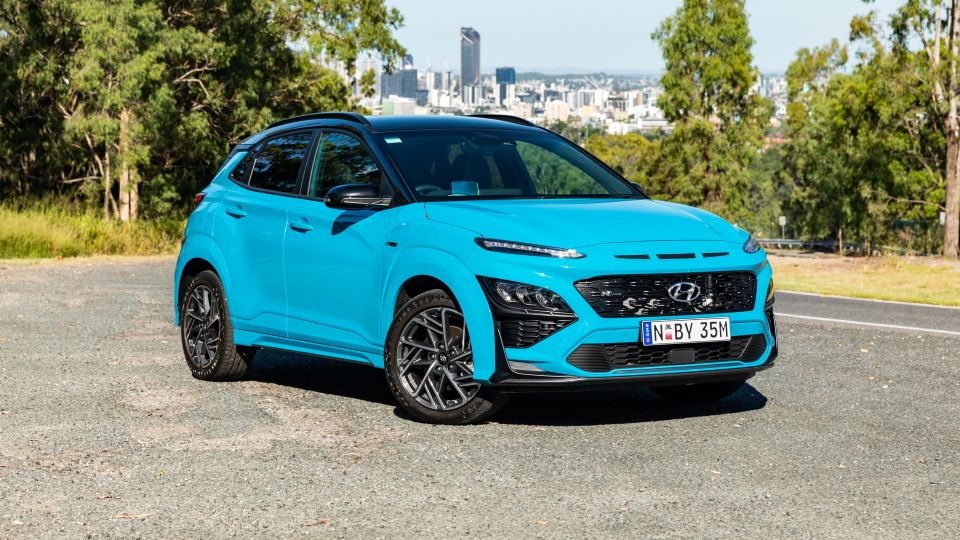
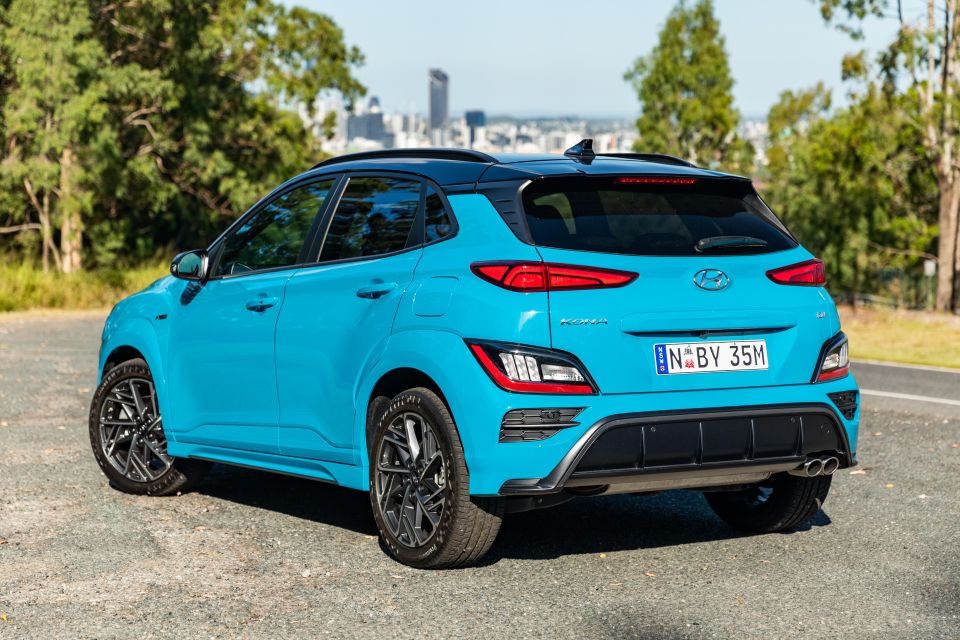

Quickly see how this car stacks up against its competition. Select any benchmark to see more details.
Where expert car reviews meet expert car buying – CarExpert gives you trusted advice, personalised service and real savings on your next new car.
For so many new car buyers today, an SUV has seemingly become the default option.
For some, it’s because of the perceived practicality advantages of the body style. For others, it’s simply down to style. Something as simple as a higher hip point and ride height is also enough to get people driving out of a showroom with a new SUV.
The Hyundai Kona N Line Premium offers precious little in extra practicality over an i30 hatchback – in many ways it’s actually worse – but it may hit the sweet spot for a particular kind of buyer.

That kind of buyer is somebody who wants a distinctive-looking SUV with plenty of equipment, plus the extra traction all-wheel drive provides.
Hyundai has kept the style-conscious Kona fresh with a facelift last year which also saw the range restructured.
While the Kona remains one of the best-selling small SUVs in Australia, the segment has flourished since the Kona was first introduced here in 2017. Does it still deserve its popularity?
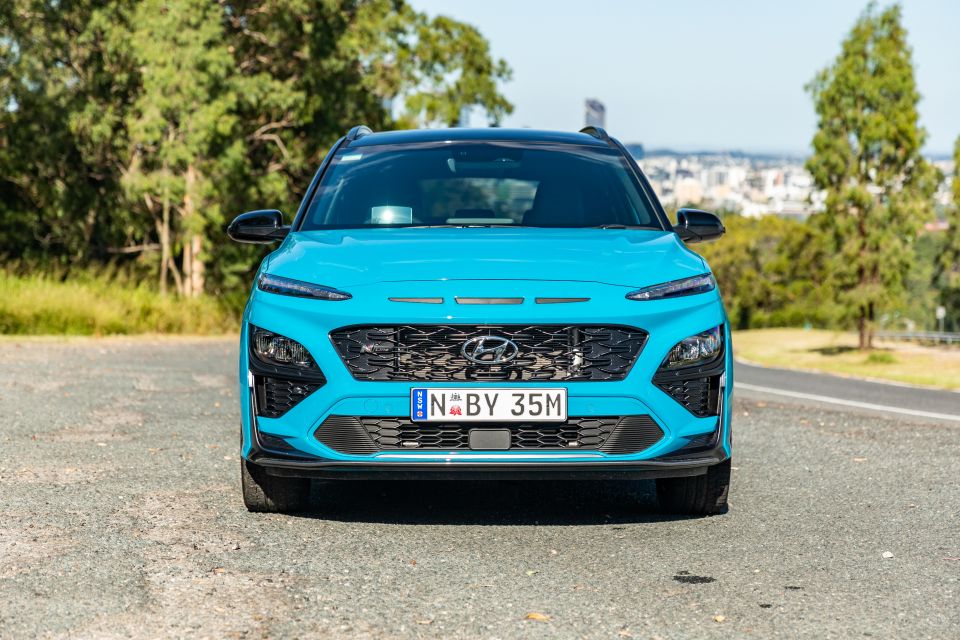
The N Line Premium is the second priciest Kona, after the hot N. It’s priced at $42,700 before on-road costs, or $46,796 drive-away based on a Sydney postcode.
Our tester came in a smashing shade of blue called Dive In Jeju, after a volcanic island in Korea known for its resorts. It’s a no-cost option, though there are a few shades that cost an extra $595.
If you opt for the black contrast roof, like with our tester, you lose the sunroof but you pay the same amount.
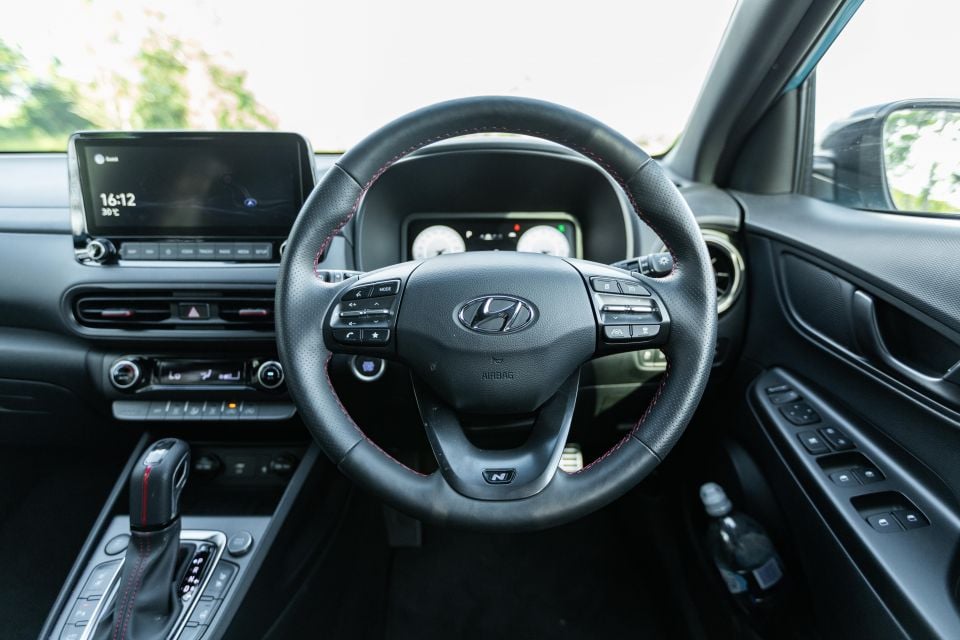
Similarly-priced rivals include:
All prices exclude on-road costs unless otherwise stated
While the Peugeot, Renault and Skoda are front-drive only, the rest of the rivals listed above are all-wheel drive.
You’re also knocking on the door of entry-level luxury-brand SUVs, albeit ones with front-wheel drive and generally less power. These include the Audi Q2 35 TFSI ($43,600) and Lexus UX200 Luxury ($44,445).
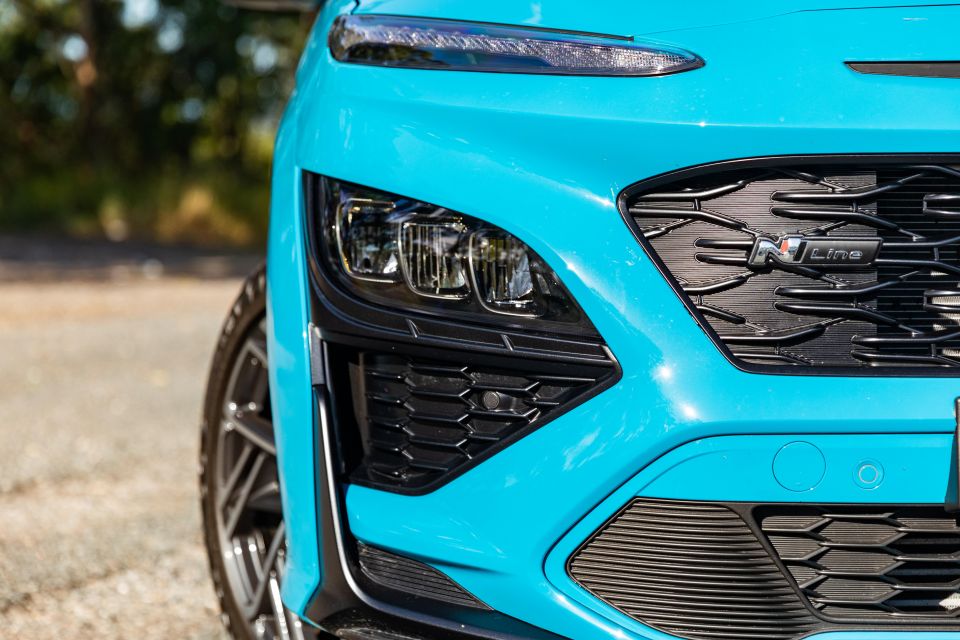
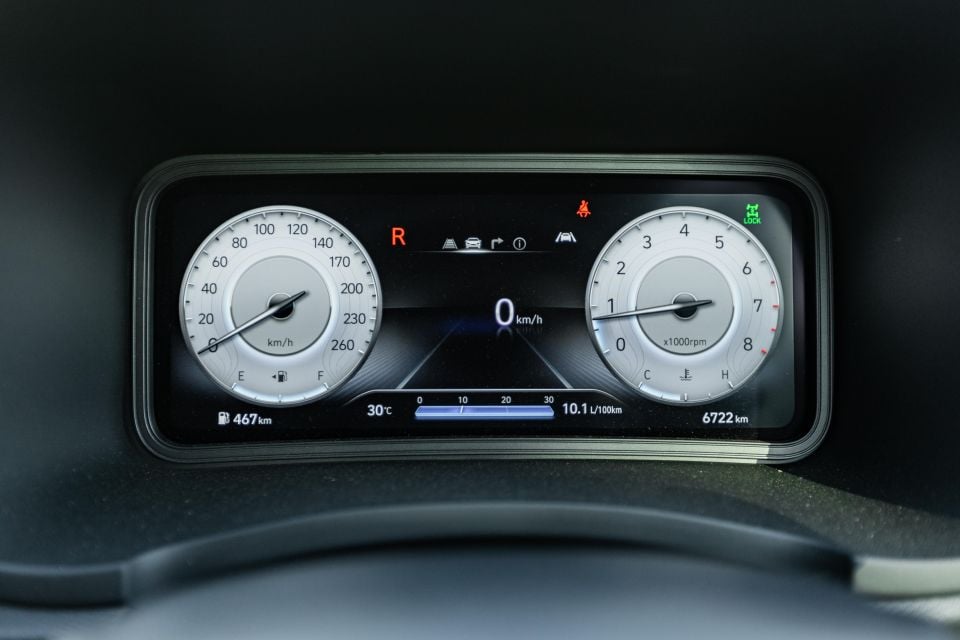
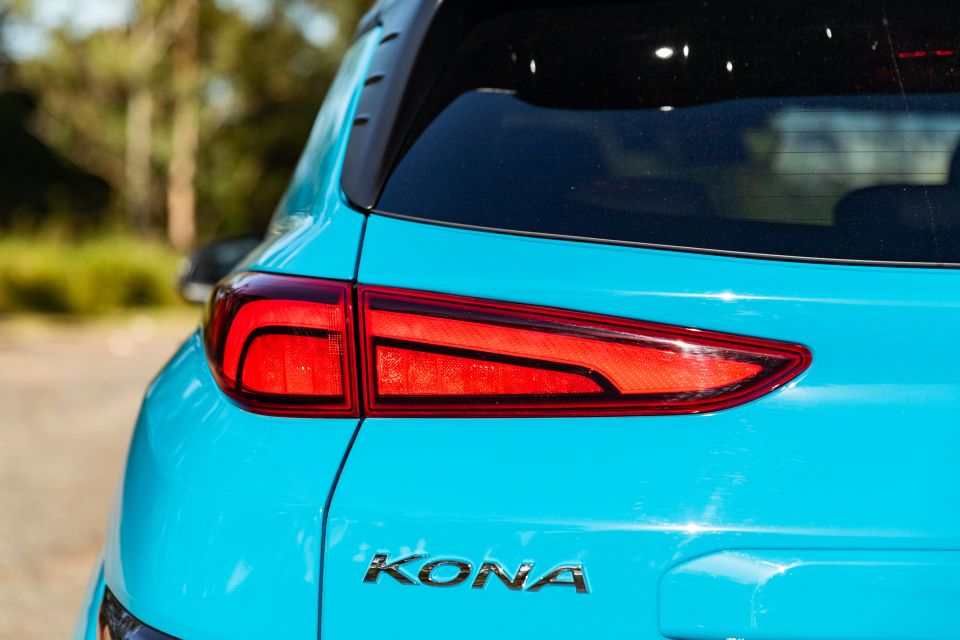
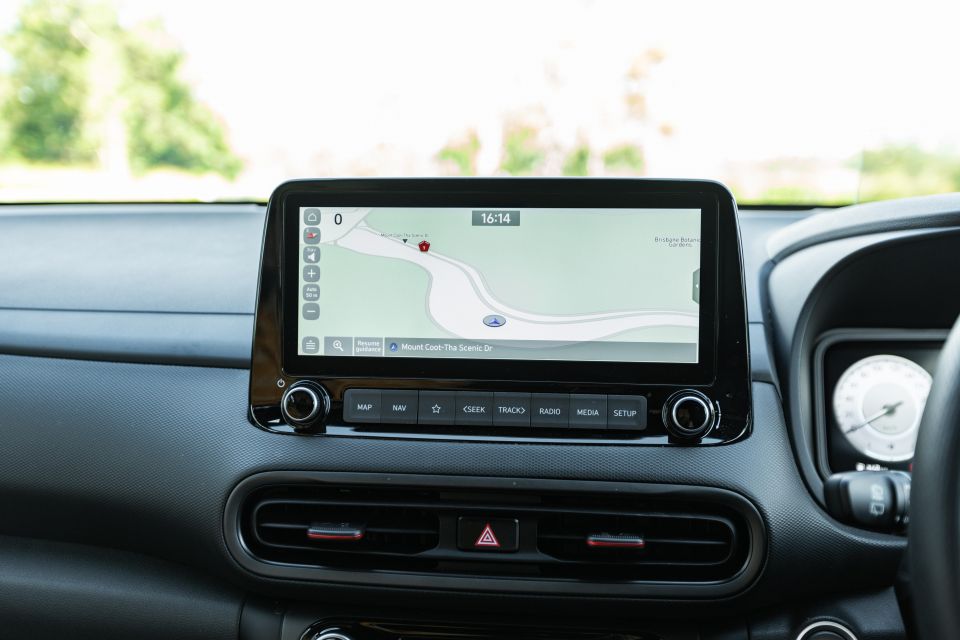
Before the Kona’s facelift in 2021, you were able to get the turbocharged 1.6-litre four-cylinder engine in every trim level. Now, it’s limited to the N Line and N Line Premium, which are unique in the core Kona line-up in featuring multi-link rear suspension, a sports suspension tune, front sports seats, alloy pedals, and a sporty body kit.
Otherwise, the N Line Premium aligns with the 2.0-litre Highlander.
Kona N Line Premium highlights:
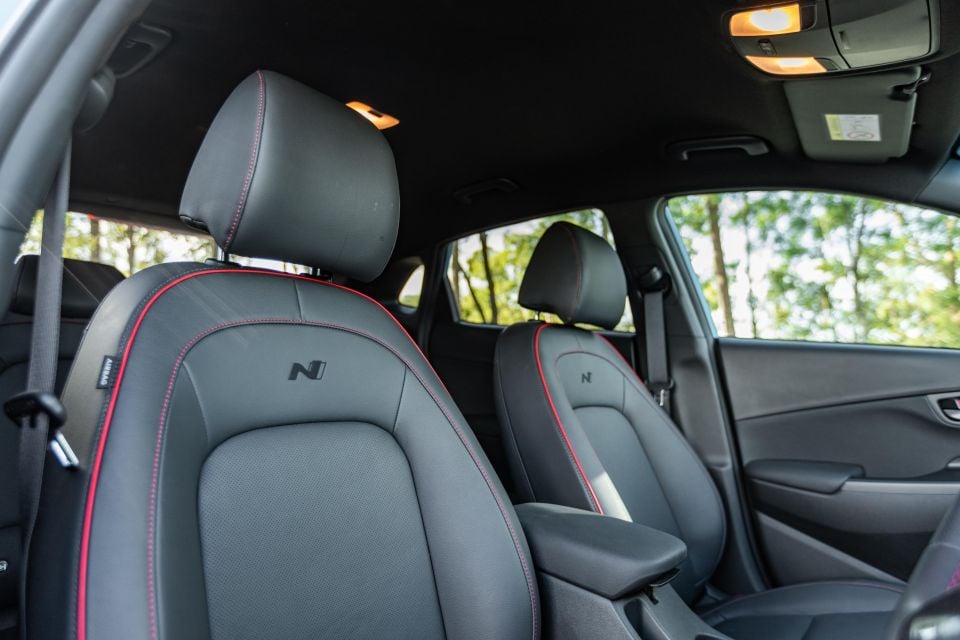
That’s above features found lower in the Kona range, including:
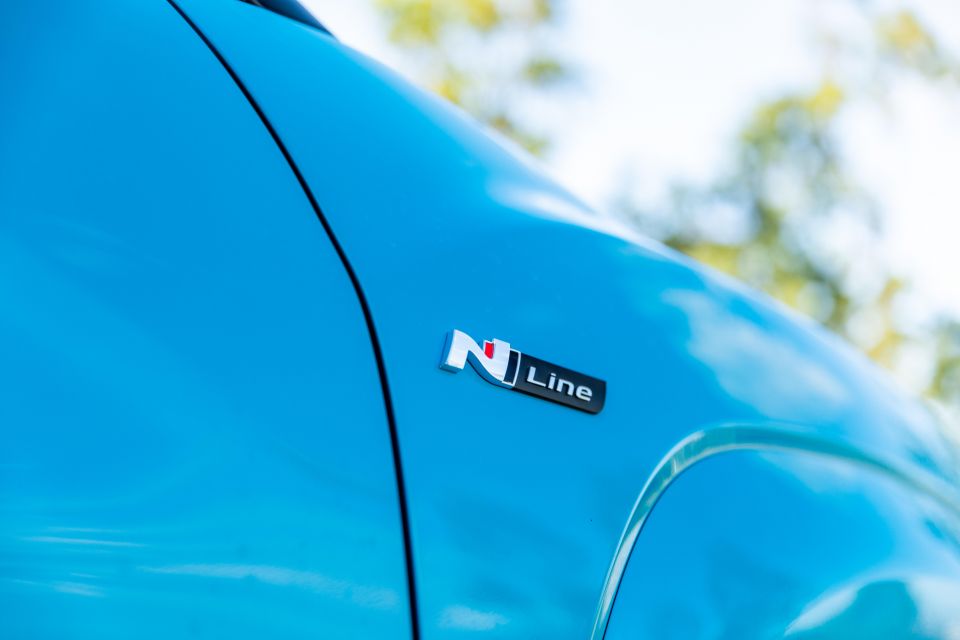
The Seltos GT-Line is equipped almost identically, though it misses out on the digital instrument cluster in favour of rear air vents.
The T-Roc Sport misses out on leather upholstery, heated and ventilated seats and a head-up display, though a $3500 Luxury package adds leather, heated front seats and two options you can’t get on any Kona: a panoramic sunroof and a power tailgate.
The CX-30 Astina, in contrast, misses out on the Kona’s ventilated front seats but gets adaptive LED headlights and a power tailgate.
Overall, the Kona stacks up well against its rivals in terms of standard equipment. It’s also very competitive when it comes to safety features.
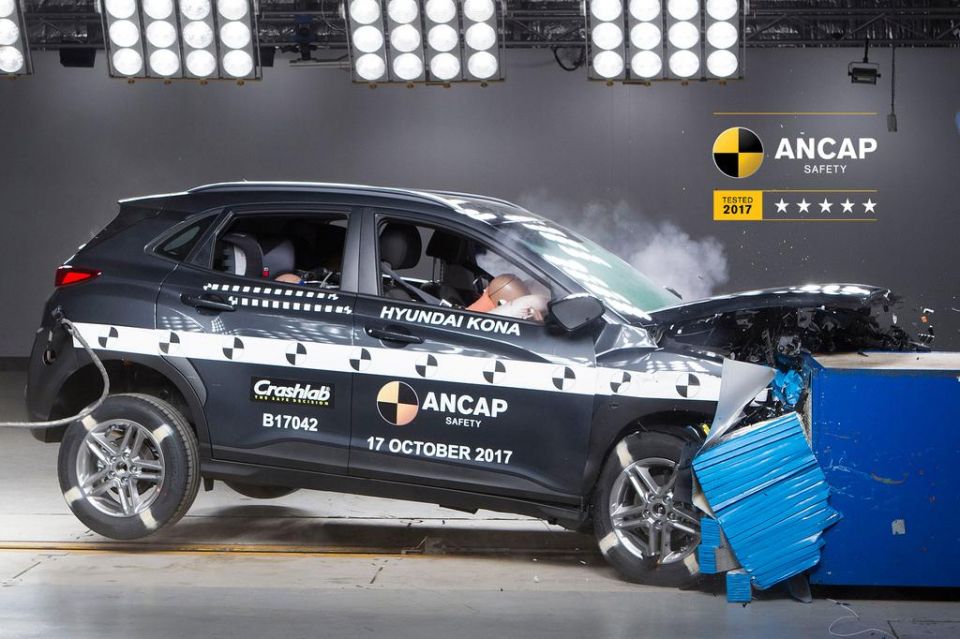
When the Hyundai Kona was tested by ANCAP in 2017, it received a rating of five stars.
That rating was based on a frontal offset score of 14.07 out of 16 and a side impact score of 16 out of 16. Whiplash and pedestrian protection were rated Good and Acceptable, respectively.
Standard safety equipment on the N Line Premium includes:
In the back of the cabin, you’ll find three top-tether points and two ISOFIX points for child seats.
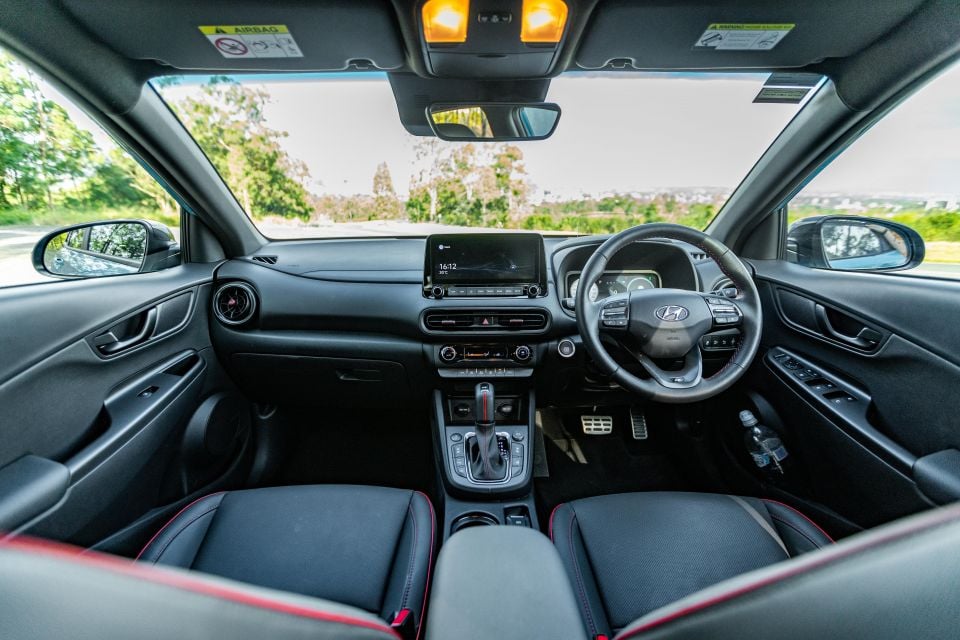
The Kona’s dashboard is simple and straightforward. The 10.25-inch touchscreen – one of the largest in the class – helpfully includes a row of hard shortcut buttons underneath. While there’s no home button, you can program the star button accordingly.
The infotainment system, in Hyundai fashion, boasts a logical layout, neat graphics and quick response times. There are also neat features like a voice memo function, a quiet mode, and Sounds of Nature – we never saw the need for any of them, but you might.
Frustratingly, smartphone mirroring is still wired, and yet it’s wireless in Hyundai models with the smaller 8.0-inch touchscreen.
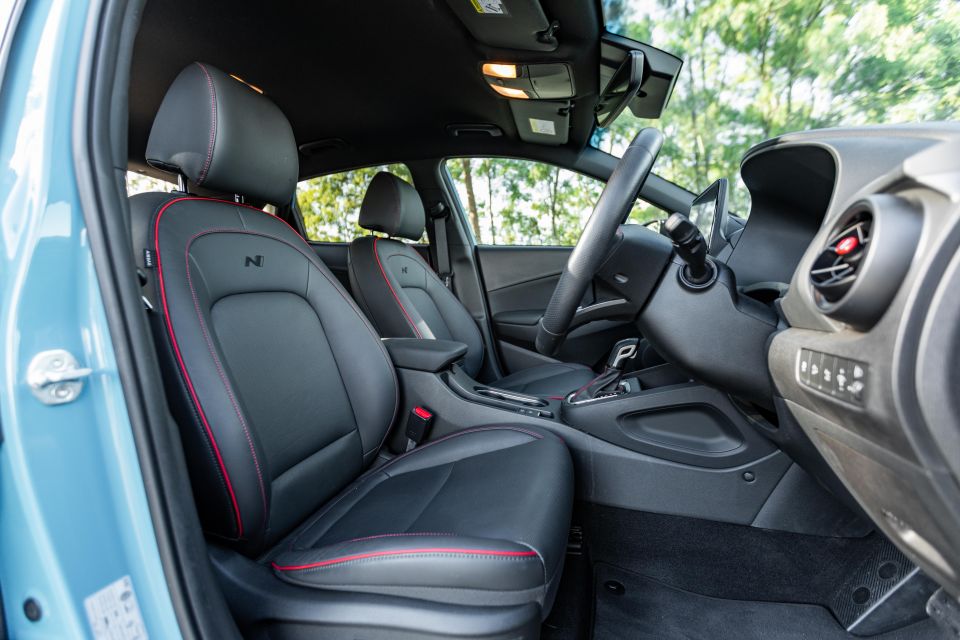
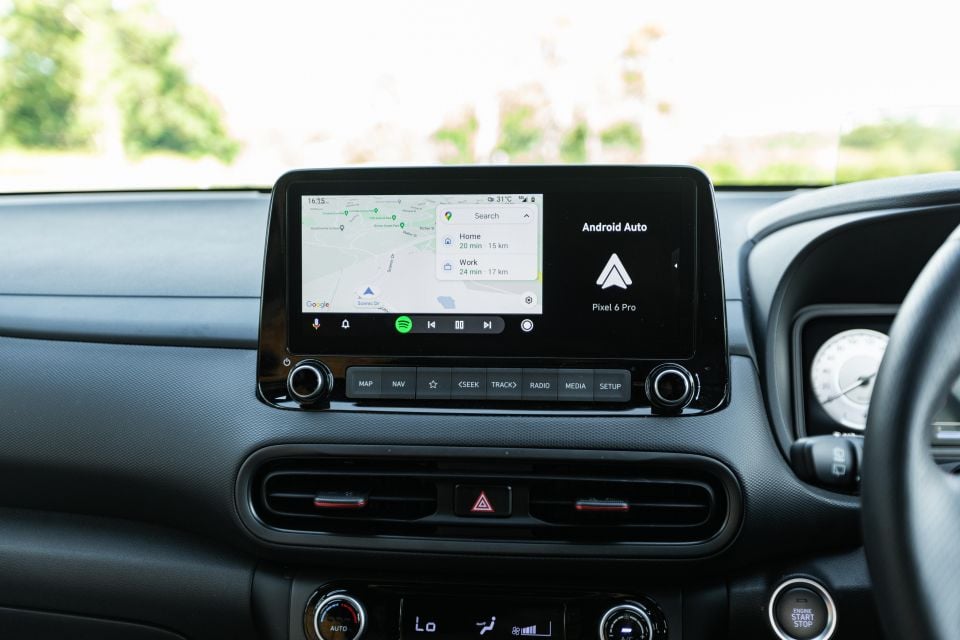
N Line models bring some red stitching elements, while the digital instrument cluster will please those who like that sort of thing – there’s not really any extra usability here, but you do get different designs based on the drive mode. Also adding some flair to a conventional interior are the circular air vents.
There’s a head-up display, which is handy, but, instead of being projected onto the windscreen, it’s displayed on a surface that whirs as it rises from the dashboard upon startup.
Soft-touch, dimpled material is used across the front of the dashboard and the door cards feature leatherette inserts, though the dimpled materials on the tops of the doors are hard as is the top of the dash.
Overall, cabin presentation and material quality is above that of the T-Roc, lineball with a Seltos, but not as plush and upscale as a CX-30. And fortunately, everything looks appropriately modern and feels well screwed together. We didn’t experience any build quality issues.
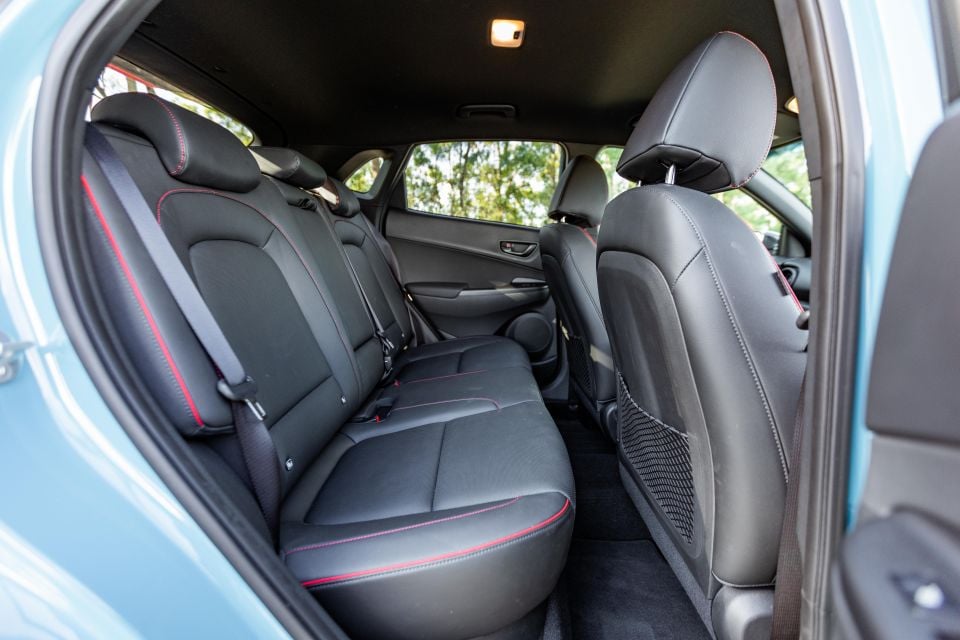
The rear of the cabin is less impressive. It’s a bit rich that in this up-spec Kona, you don’t get rear air vents – something you’ll find in even the cheapest i30 Hatch.
That sets the scene for the rear half of the Kona. Compared to the i30 hatchback, there’s less headroom (down 16mm) and less shoulder room (down 21mm).
Someone 180cm tall can sit behind a similarly-sized front seat occupant, but there’s only adequate headroom, leg room and knee room.
In terms of amenities, there’s a lone USB-A outlet, plus map pockets, bottle holders in the doors and a fold-down centre armrest.
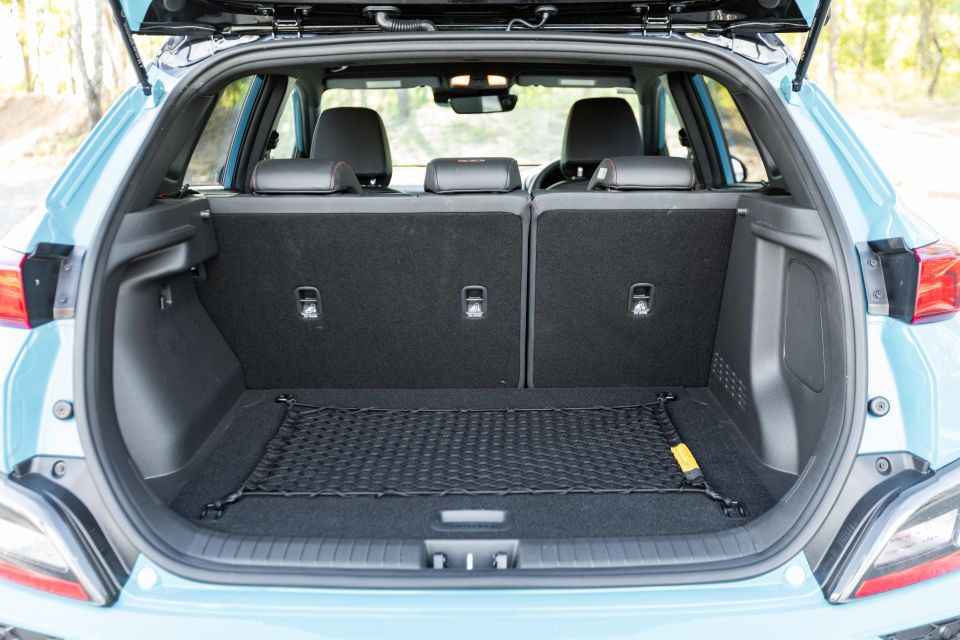
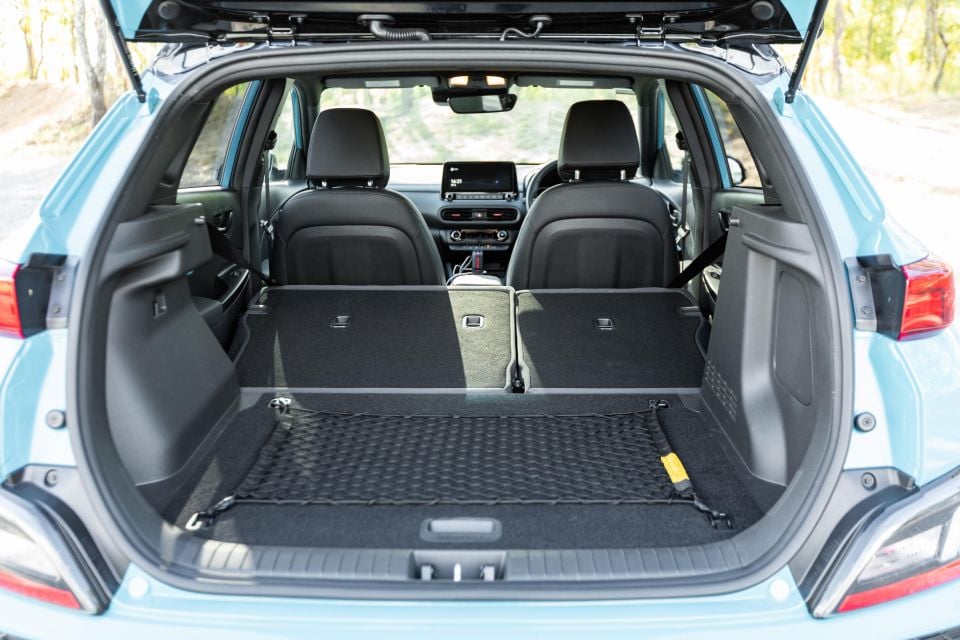
There’s also less boot space than an i30 Hatch: 374L or 1156L with the rear seats folded, compared to 395L/1305L for the i30. Under the boot floor you’ll find a space-saver spare.
Choosing the Kona to take two family members to the airport was therefore ill-advised, as we could fit only one large suitcase and one standard carry-on in the boot. That left the other two items to be awkwardly wedged in among occupants in the cabin.
For those who presume “SUV” means more practicality, the Kona is therefore a sobering reality check. At least it has all-wheel drive, something you can’t get in the i30.
But compare this with the Kia Seltos, and the Kona reveals itself to be one of the less practical models in this segment.
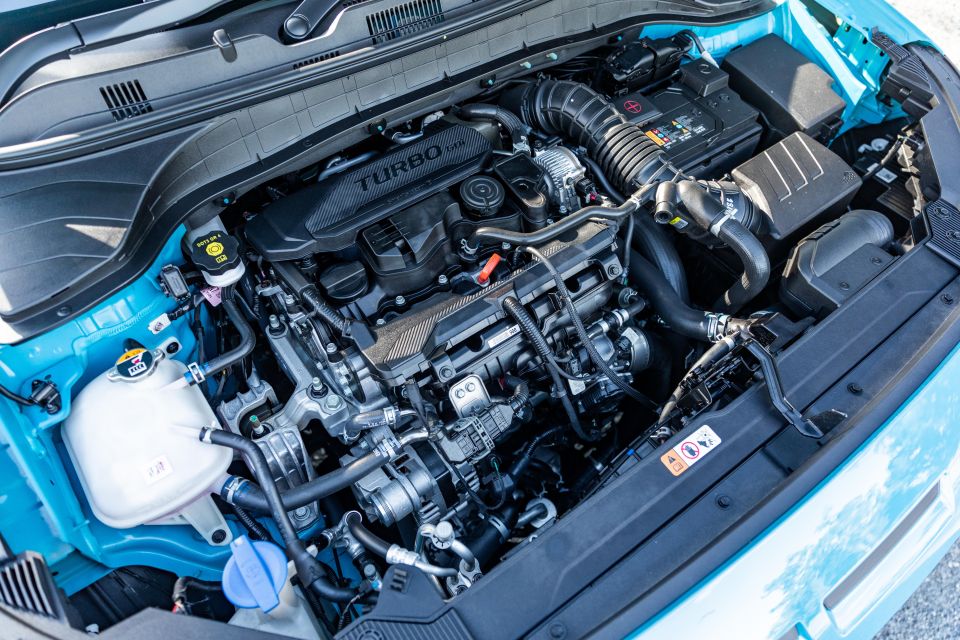
The Kona N Line and N Line Premium use a turbocharged 1.6-litre four-cylinder engine producing 146kW of power and 265Nm of torque.
It’s mated to a seven-speed dual-clutch automatic transmission and all-wheel drive.
Hyundai claims a combined cycle fuel economy rating of 6.9L/100km. Over our test loop, comprising a mix of inner-city, suburban and highway driving, the best we managed was 8.3L/100km. Over the course of a week with the Kona, this rose to 9.9L/100km.
It runs on 91 RON regular unleaded fuel.
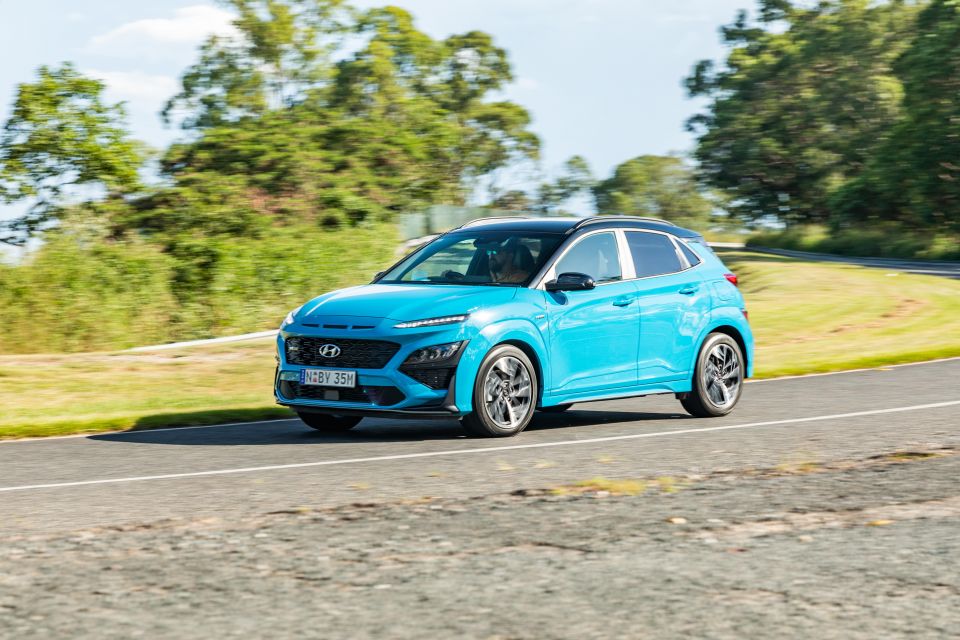
Where expert car reviews meet expert car buying – CarExpert gives you trusted advice, personalised service and real savings on your next new car.
Often the N Line badge means something a little special under the skin.
In the case of the Kona N Line Premium, there’s a more powerful engine and all-wheel drive, the latter of which you can’t even get on the Kona N, and yet it feels less than the sum of its parts. Moreover, it doesn’t impress as much as, say, an i30 Sedan N Line or a Sonata N Line.
The seven-speed dry-type dual-clutch feels much rougher at low speeds, for example when driving around car parks, than the eight-speed wet-clutch unit in the Kona N. Shifts are also more pronounced, particularly from first to second gear, and it simply doesn’t feel as smooth as the newer dual-clutch.
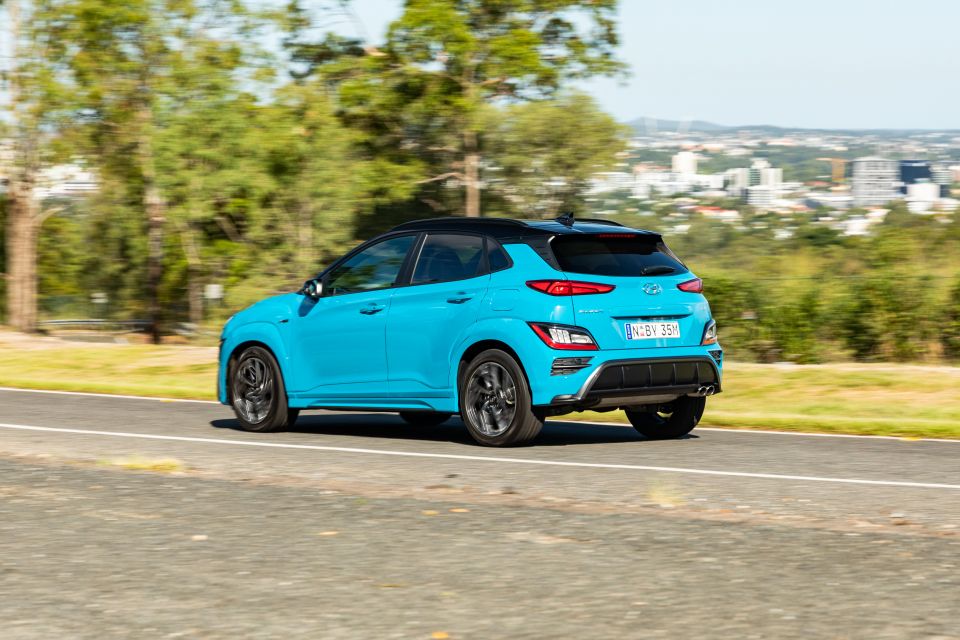
There’s no trick adjustable exhaust here like the N, so you get the unadulterated sound of the turbocharged 1.6-litre. That means a coarse engine note, exacerbated when you put it into Sport mode due to that mode’s tendency to hold gears for a touch too long. This engine is no aural delight.
The turbocharged 1.6-litre might have received a bump in power but it doesn’t feel like a hot hatch in disguise. There’s a bit of a delay off the line, a combination of both turbo lag and dual-clutch hesitation. When it’s rolling, it’s punchy enough for a small SUV but it won’t pin you back in your seat.
Sport mode quickens throttle response but, though Hyundai claims it adds heft to the steering, there’s little extra weight to be felt.
Steering in all modes is light if direct but, while the N Line Premium’s tiller might be ideal for low-speed manoeuvring around town, the lack of weight and feel means this isn’t the kind of small crossover you’ll want to take on a run through the twisties. It isn’t as engaging, for example, as a T-Roc 140TSI Sport.
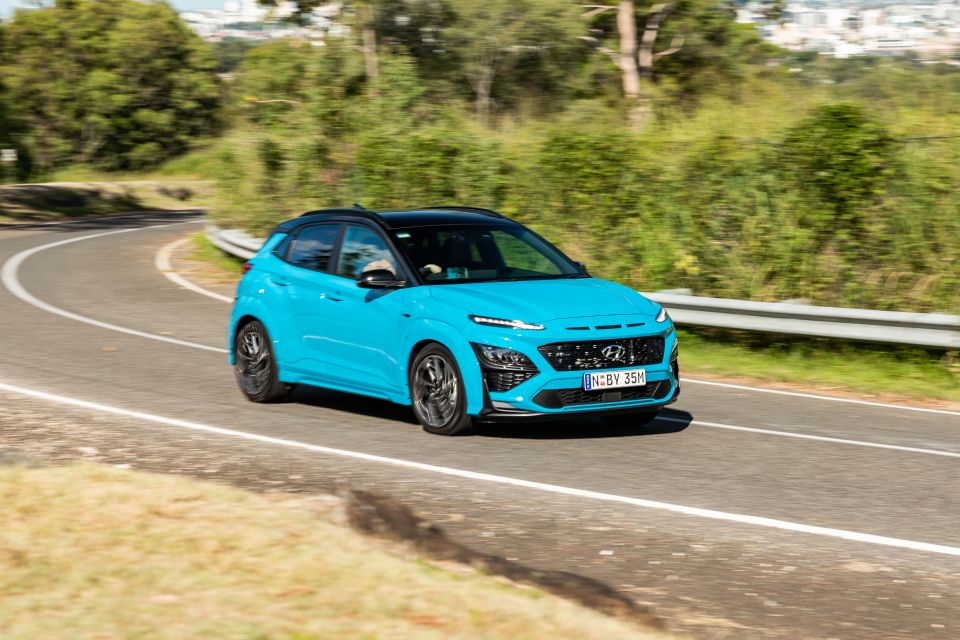
Handling is competent if unexciting, predisposed towards safe understeer. Though it might not look all that much taller than an i30 Hatch, you can feel a little bit of body lean in tight corners.
The all-wheel drive system is more reactive than proactive; there’s an all-wheel drive lock button, however this is intended for driving along muddy roads and the like.
The Kona has a firm ride, as befitting its sporting intent. It’s never crashy, however, and soaks up crags quite well. However, rebound damping could use some work – the Kona’s ride can feel too springy and takes a while to settle.
There’s plenty of tyre roar over coarse chip surfaces, and the cabin can get boomy at highway speeds.
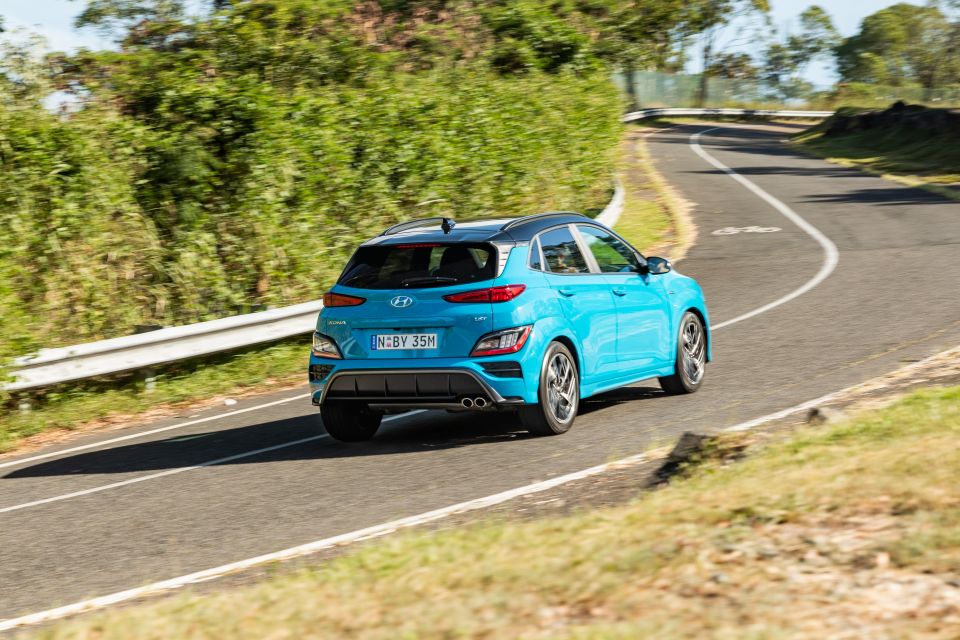
Hyundai’s lane-keep assist and Lane Following Assist systems are typically among the most capable on the market, though some drivers may bristle at just how assertive they can be. For some reason, the calibration of these systems is completely out of whack in the Kona.
The steering wheel drunkenly bobs around in your hands as the Kona tries to figure out where the lane markings are. Even the Lane Following Assist feels uncoordinated at times, while the steering feels awkwardly light.
The N Line Premium’s biggest problem isn’t that the more expensive N is much better to drive, which it is, but that the base powertrain is more well-rounded.
It might be down on power and torque, but the CVT is a much smoother transmission and the overall gulf in performance isn’t as wide as you might think.

Servicing is required every 12 months or 10,000km, whichever comes first.
The first five services are capped at $319 each. That’s cheaper than the CX-30 ($322-367 per service), T-Roc ($2300 for a five-year plan, or an average of $460), and the Seltos ($275-600 per service).
While its Kia cousin is more expensive to service, it has a seven-year, unlimited-kilometre warranty while the Hyundai has a five-year, unlimited-kilometre warranty.
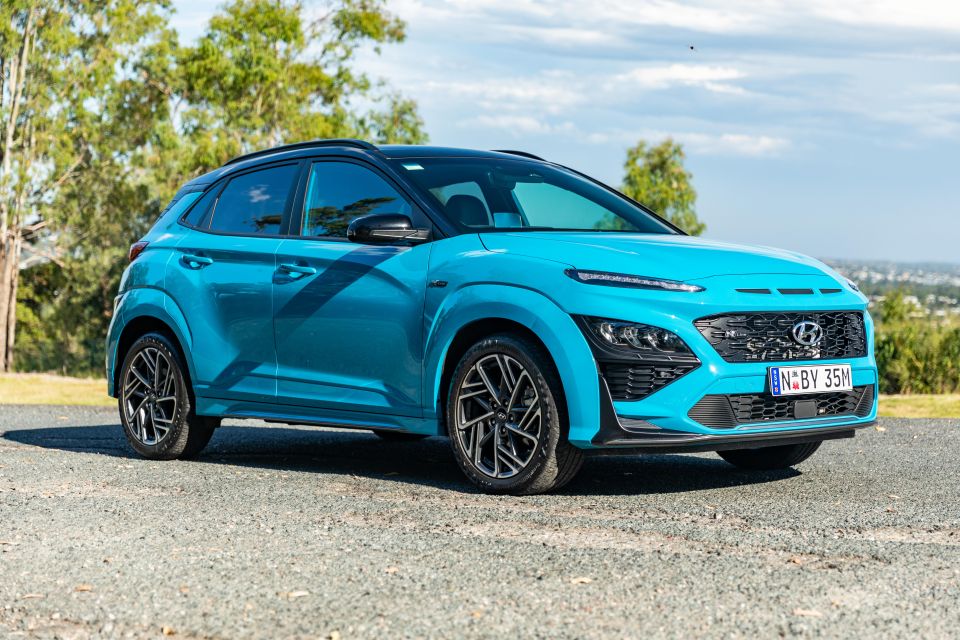
Personally, I’d pocket the $4000 and go for the 2.0-litre Highlander – or step even further down.
Considering how uninspiring some of Hyundai’s naturally-aspirated four-cylinder models can be, this might come as a surprise, but the new SmartStream 2.0-litre/CVT combo is far superior to the old base powertrain and feels vastly more polished than the turbo 1.6-litre/dual-clutch combo of the N Line and N Line Premium.
It’s frustrating as Hyundai is capable of calibrating a dual-clutch transmission well, and the Kona is a genuinely fresh, funky-looking thing, if hardly the best-packaged model in the small SUV segment.

If you want something for carrying around your family and their stuff, the Kia Seltos is a much more sensible option. If you want something engaging to drive, there’s the Kona N, if you can stomach the jump in price.
The combination of a peppy turbo engine, a dual-clutch transmission, and all-wheel drive should be a winning formula.
Alas, the Kona N Line Premium is less than the sum of its parts.

Click the images for the full gallery
MORE: Everything Hyundai Kona
Where expert car reviews meet expert car buying – CarExpert gives you trusted advice, personalised service and real savings on your next new car.
William Stopford is an automotive journalist based in Brisbane, Australia. William is a Business/Journalism graduate from the Queensland University of Technology who loves to travel, briefly lived in the US, and has a particular interest in the American car industry.


Matt Campbell
24 Days Ago


Max Davies
19 Days Ago
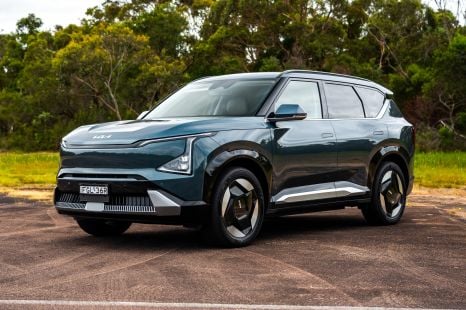

James Wong
17 Days Ago


CarExpert.com.au
10 Days Ago


Andrew Maclean
7 Days Ago
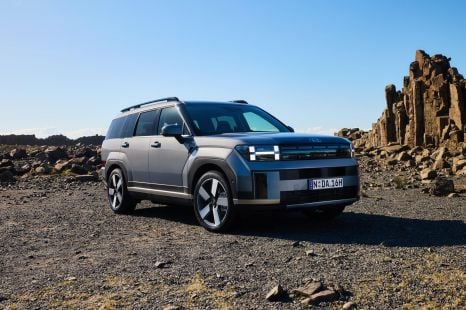

Damion Smy
3 Days Ago